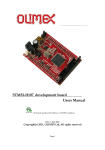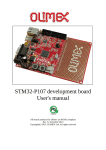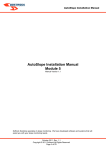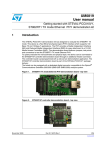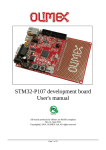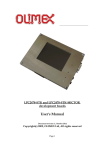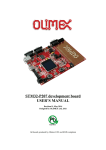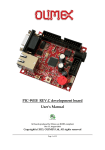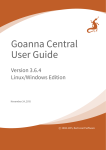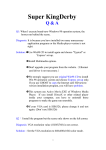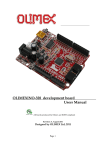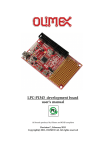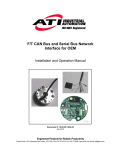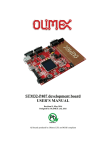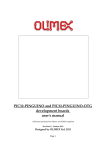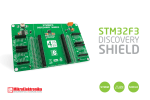Download Olimex STM32-P107 datasheet
Transcript
STM32-P107 development board User's Manual All boards produced by Olimex are ROHS compliant Rev. F, August 2012 Copyright(c) 2012, OLIMEX Ltd, All rights reserved Page 1 INTRODUCTION STM32-P107 prototype board provides easy way for developing and prototyping with the new STM32F107VCT6 connectivity line microcontroller, produced by STMicroelectronics. STM32-P107 has JTAG port for programming and debugging, USB_OTG, user button, two status leds, and most of the GPIOs are on extension headers where you can connect your additional circuits. BOARD FEATURES - CPU: STM32F107VCT6 32 bit ARM-based microcontroller with 256 KB Flash, 64 KB RAM, USB OTG, Ethernet, 10 timers, 2 CANs, 2 ADCs, 14 communication interfaces - JTAG connector with ARM 2x10 pin layout for programming/debugging - USB_OTG - USB_HOST - 100Mbit Ethernet - RS232 - Mini SD/MMC card connector - UEXT connector - Power Jack - Two user buttons - RESET button and circuit - Two status leds - Power-on led - 3V battery connector - Extension port connectors for many of microcontrollers pins - PCB: FR-4, 1.5 mm (0,062"), soldermask, silkscreen component print - Dimensions: 132.08x96.52mm (5.2x3.8") ELECTROSTATIC WARNING The STM32-P107 board is shipped in protective anti-static packaging. The board must not be subject to high electrostatic potentials. General practice for working with static sensitive devices should be applied when working with this board. Page 2 BOARD USE REQUIREMENTS Cables: The cable you will need depends on the programmer/debugger you use. If you use ARM-JTAG, you will need LPT cable, if you use ARM-JTAG-EW, ARMUSB-OCD, ARM-USB-OCD-H, ARM-USB-TINY, or ARM-USB-TINY-H you will need 1.8 meter USB A-B cable, for ARM-USB-OCD and ARM-USB-OCD-H you will need RS232 cable, too. Hardware: Programmer/Debugger – one of the Olimex ARM Programmers: ARMJTAG, ARM-JTAG-EW, ARM-USB-OCD, ARM-USB-OCD-H, ARM-USB-OCDTINY, ARM-USB-OCD-H. Software: ARM C compiler PROCESSOR FEATURES STM32-P107 board use ARM-based 32-bit microcontroller STM32F107VCT6 with these features: – – – – – Core: ARM 32-bit Cortex™-M3 CPU – 72 MHz maximum frequency, 1.25 DMIPS/MHz (Dhrystone 2.1) performance at 0 wait state memory access – Single-cycle multiplication and hardware division Memories – 256 Kbytes of Flash memory – 64 Kbytes of SRAM Clock, reset and supply management – 2.0 to 3.6 V application supply and I/Os – POR, PDR, and programmable voltage detector (PVD) – 25 MHz crystal oscillator – Internal 8 MHz factory-trimmed RC – Internal 40 kHz RC with calibration – 32 kHz oscillator for RTC with calibration Low power – Sleep, Stop and Standby modes – VBAT supply for RTC and backup registers 2 × 12-bit, 1 µs A/D converters (16 channels) – Conversion range: 0 to 3.6 V – Sample and hold capability – Temperature sensor – up to 2 MSps in interleaved mode – 2 × 12-bit D/A converters – DMA: 12-channel DMA controller Page 3 – – – Debug mode – Serial wire debug (SWD) & JTAG interfaces – Cortex-M3 Embedded Trace Macrocell™ 80 fast I/O ports – – – – Supported peripherals: timers, ADCs, DAC, I2Ss, SPIs, I2Cs and USARTs 80 I/Os, all mappable on 16 external interrupt vectors and almost all 5 V-tolerant 10 timers – four 16-bit timers, each with up to 4 IC/OC/PWM or pulse counter and quadrature (incremental) encoder input – 1 × 16-bit motor control PWM timer with dead-time generation and emergency stop – 2 × watchdog timers (Independent and Window) – SysTick timer: a 24-bit downcounter – 2 × 16-bit basic timers to drive the DAC 14 communication interfaces – 2 × I2C interfaces (SMBus/PMBus) – 5 USARTs (ISO 7816 interface, LIN, IrDA capability, modem control) – 3 SPIs (18 Mbit/s), 2 with a multiplexed I2S interface that offers audio class accuracy via advanced PLL schemes – 2 × CAN interfaces (2.0B Active) with 512 bytes of dedicated SRAM – USB 2.0 full-speed device/host/OTG controller with on-chip PHY that supports HNP/SRP/ID with 1.25 Kbytes of dedicated SRAM – 10/100 Ethernet MAC with dedicated DMA and SRAM (4 Kbytes): IEEE1588 hardware support, MII/RMII available on all packages CRC calculation unit, 96-bit unique ID Page 4 BLOCK DIAGRAM Page 5 MEMORY MAP Page 6 SCHEMATIC 97 98 1 2 3 4 5 38 39 40 41 42 43 44 45 46 ETH_RMII_MDINT USB_FAULT PE0/TIM4_ETR PE1 PE2/TRACECK PE3/TRACED0 PE4/TRACED1 PE5/TRACED2 PE6/TRACED3 PE7/TIM1_ETR PE8/TIM1_CH1N PE9/TIM1_CH1 PE10/TIM1_CH2N PE11/TIM1_CH2 PE12/TIM1_CH3N PE13/TIM1_CH3 PE14/TIM1_CH4 PE15/TIM1_BKIN PD0/OSC_IN/CAN1_RX PD1/OSC_OUT/CAN1_TX PD2/TIM3_ETR/UART5_RX PD3/USART2_CTS PD4/USART2_RTS PD5/USART2_TX PD6/USART2_RX PD7/USART2_CK PD8/USART3_TX/ETH_MII_RX_DV PD9/USART3_RX/ETH_MII_RX_D0 PD10/USART3_CK/ETH_MII_RX_D1 PD11/USART3_CTS/ETH_MII_RX_D2 PD12/TIM4_CH1/USART3_RTS/ETH_MII_RX_D3 PD13/TIM4_CH2 PD14/TIM4_CH3 PD15/TIM4_CH4 81 82 83 84 85 86 87 88 55 56 57 58 59 60 61 62 SPI3_SCK SPI3_MISO SPI3_MOSI TAMPER SPI3_SCK SPI3_MISO SPI3_MOSI GN D C14 10pF C15 10pF JTAG 1 2 HN1x2(Open) 3.3V U3 RM3G1 TDO RST TRST 1 R-T R26 330R D5 BOOT0_E 1 2 BOOT0 HN1x2(Open) 12 9 R1OUT R2OUT 3.3V 13 PC_TXD 8 PC_CTS R1IN R2IN 16VCC GND15 U3PWR C29 100nF 1N4148 1 2 3 4 5 R30 6 7 8 9 R27 NA TAMPER TAMPER 330R R29 100R/1% R36 R37 NA WKUP 330R 3.3V NA(33k) POWER SUPPLY CIRCUIT VDD E/D 1N5819S +5V_EXT D4 1N5819S VR2(3.3V) LM1117IMPX-ADJ IN 1 C9 C10 2.2uF/6.3V + 47uF/6.3V/TANT C7 + C6 100nF 47uF/6.3V/TANT C4 24 0R/1% 2 R9 3 90R/1 % C8 N A (1 0 u F /6 .3 V ) R7 300R/1% 100nF GND 100nF ETH_RMII_REF_CLK R50 4.99k/1% R49 1.5k/1% 36 35 34 33 32 31 1k 30 29 NA 28 27 330R 26 330R 330R 25 R47 R46 R45 R44 USB GND3 GND4 R5 R4 SPI3_SCK SPI3_MISO SPI3_MISO 33k 33k 33k R3 R2 R1 L3 CL470 nH/08 05/1.7 6R/250 mA C40 47uF/6.3V/TANT LAN LAN 1 3 2 AG KG AY KY 7 6 8 10k R43 TD+ COM TDAG KG AY KY RD+ NC RD- 1:1 75 U2 YEL LOW 1:1 75 R48 3.3V 3.3V 3.3V C48 100nF R61 10k STAT1 STAT2 NA(STM1001RWX6F) 2 VCC RESET 1 R62 330R R63 100R/1% GND 1 2 AGND GREEN(GYX-SD-TC0805SGC) YELLOW(GYX-SD-TC0805SYC) RESET 3 7 8 6 R58 4.7k 3.3V UEXT UEXT_PWR_E CLOSE UEXT USART3_TX I2C1_SCL SPI3_MISO SPI3_SCK 1 3 5 7 9 2 4 6 8 10 R59 4.7k USART3_RX I2C1_SDA SPI3_MOSI CS_UEXT BH10S 3.3V PB2/BOOT1 R64 10k R57 330R 75 1nF/2 kV 1 4 5 2 RJLBC-060TC1 3.3V KS8721BLMM RESET CIRCUIT 3.3V 75 GRE EN 3.3V 3.3V GNDA_E CLOSE GND1 GND2 C36 C35 100nF C37 10uF/6.3V 100nF 10k 33k 1.5k/1% R21 1 2 3 R22 1M 10k 3.3V 10uF/6.3V GND5 GND4 FXSD/FXEN RX+ RXVDDRX PD# LED3/NWAYEN LED2/DUPLEX LED1/SPD100/NFEF LED0/TEST INT/PHYAD0 3 100nF C3 C49 U4 R56 330R C2 100nF 100nF L5 MDIO MDC RXD3/PHYAD1 RXD2/PHYAD2 RXD1/PHYAD3 RXD0/PHYAD4 VDDIO1 GND1 RXDV/CRSDV/PCS_LPBK RXC RXER/ISO GND2 OUT CLOSE C11 R8 C44 C43 STAT2 STAT1 3.3VA_E OUT ADJ/GND + 10uF/6.3V STATUS LEDS 2 D3 CS_MMC SPI3_MOSI 3.3VA 1 +5V_OTG_PWR 3.3V_E CLOSE MICRO 3.3V CS_MMC SPI3_MOSI SPI3_SCK,SPI3_MOSI,SPI3_MISO,CS_UEXT,I2C1_SCL,I2C1_SDA,USART3_TX,USART3_RX,SPI1_NSS,SPI1_SCK,SPI1_MISO,SPI1_MOSI,USART2_TX,USART2_RX,USART2_RTS,USART2_CTS 3.3V 330R PWR_LED RED(GYX-SD-TC0805SYRK) C5 GND_PIN 2 R6 100R/1% NA(10uF/6.3V) C1 470uF/16VDC + 6VAC (6.5-9)VDC VO GND/ADJ 1N5819S 47uF/6.3V/TANT VI 1 3 YDJ-1136 D2 2 3 6 4 5 7 8 1 CD/DAT3/CS CMD/DI VSS VDD CLK/SCLK DAT0/DO DAT1/RES DAT2/RES 2 4 6 8 10 12 14 16 18 20 3.3VA R10 +5V_JTAG VSS C50 1 NA(6NC2-50MHz) +5V PWR_JACK 1 2 3 4 5 6 7 8 9 10 11 12 R41 CD1 2 VR1(5.0V) AME1085 10k R39 ETH_RXER R34 R35 0R(NA) NA 3.3V 1k 3 G1 0R R38 R32 100R/1% 3.3V 1 3 5 7 9 11 13 15 17 19 PHY_VDD_PLL PHY_RSTN ETH_RMII_CRS_DV C31 100nF 4 DB 104(S M D) 10k ETH_RMII_RXD1 ETH_RMII_RXD0 R31 33k +5V +5V_JTAG FB0805/600R/200mA(201209-601) C41 100nF C42 10uF/6.3V R33 C30 100nF MICRO_AB 2.5V 1k 1k 1k 1k 47k 1N4148 D6 WKUP L1 FB0805/600R/200mA(201209-601) BH20S 3.3V R28 10k RS232 PC_DCD 14 PC_RXD 7 PC_RTS T1OUT T2OUT 10k 10k SD/MMC JTAG OPEN ETH_RMII_MDIO ETH_RMII_MDC T1103NE-DTSM-21R(12x12x4.3mm) T1IN T2IN RM4G3 RM4G4 2 RM1G1 RM1G2 RM1G3 RM1G4 USART2_RX USART2_CTS C2- 11 10 10k 3.3V 3.3V T1103NE-DTSM-21R(12x12x4.3mm) R25 330R R65 C2+ 5 USART2_TX USART2_RTS 6 V- DTC114YKA C26 4 100nF 10k RM4G1 10k C28 100nF C27 100nF 2 V+ C1- 1k C1+ 3 C39 100nF USART3_TX USART3_RX T2 ST3232BDR(SO16) C25 1 100nF C38 2.2uF/6.3V USB_OTG VBUS DD+ ID GND SD/MMC 3.3V RM4G2 RM3G2 RM3G3 RM3G4 10k 10k 10k 10k R24 NA TRST TDI TMS TCK USART2_CTS USART2_RTS USART2_TX USART2_RX BUTTONS RST_E 1 2 3 1 2 3 ETH_RMII_RXD0 ETH_RMII_RXD1 RST PHY_SOFT_RST RST +5V_OTG_PWR USB_OTG_DUSB_OTG_D+ OTG_ID OTG_ID STM32F107VCT6 RS232 USB_OTG +5V_OTG_PWR USB_OTG_DUSB_OTG_D+ USB_HOST_DUSB_OTG_D- RJ45 SIDE NRST NC 3.3V 0 1 1 2 3 PE0 PE1 PE2 PE3 PE4 PE5 PE6 PE7 PE8 PE9 PE10 PE11 PE12 PE13 14 73 33k 100nF C47 RST RST ETH_RMII_MDC PC6 PC7 PC8 PC9 PC10 PC11 PC12 PC13 Q2 NA 32768Hz/6pF R16 PD0 PD1 PD2 USART2_CTS PD3 USART2_RTS PD4 USART2_TX PD5 USART2_RX PD6 USB_VBUSON USART3_TX PD8 USART3_RX PD9 PD10 PD11 PD12 ETH_RXER PD13 PHY_SOFT_RST PD14 PD15 H 100nF C46 OSC_OUT NA(47pF) 100nF O + OSC_IN 13 150R NA (US BLC6-2P6) 49.9R/1% 49.9R/1% 49.9R/1% NA 49.9R/1% R15 C34 SHIELD USB_A FB0805/600R/200mA(201209-601) CS_UEXT PC2 PC3 ETH_RMII_RXD0 ETH_RMII_RXD1 STAT1 STAT2 C33 LM3526-L R23 USB_DHN1x3(O:Close,H:Open) ETH_RMII_TX_EN ETH_RMII_TXD0 ETH_RMII_TXD1 PC0 ETH_RMII_MDC 1 2 3 R51 R52 R53 R54 R55 R14 NA Q1 Q25.000MHz/HC-49SM(SMD)/20pF C13 27pF 12 15 16 17 18 33 34 63 64 65 66 78 79 80 7 8 9 C32 6 5 4 LED100/DUP LEDACT B0_0/B0_1 PC0/ADC12_IN10 PC1/ADC12_IN11/ETH_MII_MDC/ETH_RMII_MDC PC2/ADC12_IN12/ETH_MII_TXD2 PC3/ADC12_IN13/ETH_MII_TX_CLK PC4/ADC12_IN14/ETH_MII_RXD0/ETH_RMII_RXD0 PC5/ADC12_IN15/ETH_MII_RXD1/ETH_RMII_RXD1 PC6/I2S2_MCK/TIM3_CH1 PC7/I2S3_MCK/TIM3_CH2 PC8/TIM3_CH3 PC9/TIM3_CH4 PC10/UART4_TX/USART3_TX/SPI3_SCK PC11/UART4_RX/USART3_RX/SPI3_MISO PC12/UART5_TX/USART3_CK/SPI3_MOSI PC13/TAMPER-RTC PC14/OSC32_IN PC15/OSC32_OUT BOOT0 R20 100nF C45 94 R19 22R 8 #ENA OUT_A 7 FLAG_A IN 6 FLAG_B GND 5 #ENB OUT_B 2 1 2 3 C12 27pF 10k 1 22R OTG_DM NA(47pF) I2C1_SCL I2C1_SDA PB14 PB15 CS_UEXT OTG_DP 1 2 3 4 1 R13 HN1x3 0 VBAT ETH_RMII_TX_EN ETH_RMII_TXD0 ETH_RMII_TXD1 USB_FAULT U6 PB0 PB1 PB2TDO TRST PB5 PB6 PB7 PB8 PB9 PB10 I2C1_SCL I2C1_SDA USB_VBUSON USB_HOST_D+ USB_OTG_D+ 3.3V 47k +5V U5 DTA114YKA ETH_RMII_MDINT 1 2 6 H T1107A(6x3,8x2,5mm) BOOT0 D1 BAT54C 3V_BAT WF2S TMS TCK TDI T1 3.3V ETH_RMII_REF_CLK ETH_RMII_TX_EN ETH_RMII_TXD0 ETH_RMII_TXD1 RM2G1 1k RM2G2 1k RM2G3 1k RM2G4 1k 3.3V 4 USB_D+ HN1x3(O:Close,H:Open) O PB2/BOOT1 TDO TRST USB_HOST +5V_HOST_PWR 1 USB_HOST_D2 USB_HOST_D+ 3 L2 ETH_RMII_CRS_DV 48 47 46 45 44 43 42 41 40 39 38 37 VREF- VREFVBAT CS_MMC 33R 3.3V VREF+ 20 0R(NA) +5V_HOST_PWR USB_HOST_DUSB_HOST_D+ RST# VDDPLL XI XO GND8 GND7 VDDTX TX+ TXGND6 VDDRCV REXT 21 ETH_RMII_CRS_DV R17 OTG_VBUS OTG_ID OTG_DM OTG_DP TMS TCK +5V_HOST_PWR +5V_OTG_PWR VDDC TXER TXC/REFCLK TXEN TXD0 TXD1 TXD2 TXD3 COL/RMII CRS/RMII_BTB GND3 VDDIO2 NA CS_MMC USB_HOST H 1k 100nF C24 PA3 PA4 PA5 PA6 O 0R 1k 0R(NA) C23 ETH_RMII_REF_CLK ETH_RMII_MDIO 13 14 15 16 17 18 19 20 21 22 23 24 VSSA 35 36 37 89 90 91 92 93 95 96 47 48 51 52 53 54 PA0 L6 19 PB0/ADC12_IN8/TIM3_CH3/ETH_MII_RXD2/TIM1_CH2N PB1/ADC12_IN9/TIM3_CH4/ETH_MII_RXD3/TIM1_CH3N PB2/BOOT1 PB3/JTDO/SPI3_SCK/TRACESWO/TIM2_CH2/SPI1_SCK PB4/JNTRST/SPI3_MISO/TIM3_CH1/SPI1_MISO PB5/I2C1_SMBAL/SPI3_MOSI/ETH_MII_PPS_OUT/ETH_RMII_PPS_OUT/TIM3_CH2/SPI1_MOSI/CAN2_RX PB6/I2C1_SCL/TIM4_CH1/USART1_TX/CAN2_TX PB7/I2C1_SDA/TIM4_CH2/USART1_RX PB8/TIM4_CH3/ETH_MII_TXD3/I2C1_SCL/CAN1_RX PB9/TIM4_CH4/I2C1_SDA/CAN1_TX PB10/I2C2_SCL/USART3_TX/ETH_MII_RX_ER/TIM2_CH3 PB11/I2C2_SDA/USART3_RX/ETH_MII_TX_EN/ETH_RMII_TX_EN/TIM2_CH4 PB12/SPI2_NSS/I2S2_WS/I2C2_SMBAL/USART3_CK/TIM1_BKIN/CAN2_RX/ETH_MII_TXD0/ETH_RMII_TXD0 PB13/SPI2_SCK/I2S2_CK/USART3_CTS/TIM1_CH1N/CAN2_TX/ETH_MII_TXD1/ETH_RMII_TXD1 PB14/SPI2_MISO/TIM1_CH2N/USART3_RTS PB15/SPI2_MOSI/I2S2_SD/TIM1_CH3N WKUP ETH_RMII_REF_CLK ETH_RMII_MDIO R42 VDDA VREF+ 33R 0R C22 100nF 23 24 25 26 29 30 31 32 67 68 69 70 71 72 76 77 R40 C21 10uF/6.3V R12 VSS VSS VSS VSS VSS 22 F B0805/ 600R/ 200mA(201209-601) PA0/WKUP/USART2_CTS/ADC12_IN0/TIM2_CH1_ETR/TIM5_CH1/ETH_MII_CRS_WKUP PA1/USART2_RTS/ADC12_IN1/TIM5_CH2/TIM2_CH2/ETH_MII_RX_CLK/ETH_RMII_REF_CLK PA2/USART2_TX/TIM5_CH3/ADC12_IN2/TIM2_CH3/ETH_MII_MDIO/ETH_RMII_MDIO PA3/USART2_RX/TIM5_CH4/ADC12_IN3/TIM2_CH4/ETH_MII_COL PA4/SPI1_NSS/DAC_OUT1/USART2_CK/ADC12_IN4 PA5/SPI1_SCK/DAC_OUT2/ADC12_IN5 PA6/SPI1_MISO/ADC12_IN6/TIM3_CH1/TIM1_BKIN PA7/SPI1_MOSI/ADC12_IN7/TIM3_CH2/ETH_MII_RX_DV/ETH_RMII_CRS_DV/TIM1_CH1N PA8/USART1_CK/OTG_FS_SOF/TIM1_CH1/MCO PA9/USART1_TX/TIM1_CH2/OTG_FS_VBUS PA10/USART1_RX/TIM1_CH3/OTG_FS_ID PA11/USART1_CTS/CAN1_RX/TIM1_CH4/OTG_FS_DM PA12/USART1_RTS/CAN1_TX/TIM1_ETR/OTG_FS_DP PA13/JTMS/SWDIO PA14/JTCK/SWCLK PA15/JTDI/SPI3_NSS/TIM2_CH1_ETR/SPI1_NSS R18 OTG_VBUS C51 100nF 100nF C20 100nF C19 100nF C18 L4 R11 VDD VDD VDD VDD VDD 10 27 99 74 49 3.3V 2 1 CLOSE 3.3VA_MCU_E 3.3VA 100nF C17 100nF C16 50 75 100 28 11 USB CIRCUIT VBUS HN1x3(O:Close,H:Open) U1 FB0805/600R/200mA(201209-601) 1 2 3.3V_MCU_E CLOSE USB STM32-P107_rev_B OLIMEX LTD BULGARIA www.olimex.com 3.3V C52 100nF RST B1_0/B1_1 HN1x3 R60 33k BOARD LAYOUT POWER SUPPLY CIRCUIT STM32-P107 can take power from three sources: – PWR connector where (6.5-9)V DC or 6V AC is applied by external power source. – +5V_ OTG-PWR from USB OTG – +5V_JTAG from JTAG The programmed board power consumption is about 70 mA. RESET CIRCUIT STM32-P107 reset circuit includes JTAG connector pin 15, U2 (STE101P) pin 28 (RESET), R73(10k), R74(330Ohm), R75(100Ohm/1%), C55(100nF), STM32F107 pin 14 (NRST) and RESET button. Page 8 CLOCK CIRCUIT Quartz crystal 25 MHz is connected to STM32F107 pin 12 (OSC_IN) and pin 13 (OSC_OUT). Quartz crystal 32.768kHz is connected to STM32F107 pin 8 (PC14/OSC32_IN) and pin 9 (PC15/OSC32_OUT). JUMPER DESCRIPTION PWR_SEL When position 1-2 is shorted – the board is power supplied from JTAG. When position 3-4 is shorted – the board is power supplied from USB_OTG. When position 5-6 is shorted – the board is power supplied from External power source. Default state is – position 5-6 – shorted. B0_0/B0_1 When this jumper is in position B0_1 – BOOT0 is connected to 3.3V, and when the jumper is in position B0_0 – BOOT0 is connected to GND. Default state is B0_0. B1_0/B1_1 When this jumper is in position B1_1 – BOOT1 is connected to 3.3V, and when the jumper is in position B1_0 – BOOT1 is connected to GND. Default state is B1_0. VBUS When is in position “H” - connects +5V_HOST_PWR to OTG_VBUS. When is in position “O” - connects +5V_OTG_PWR to OTG_VBUS. Default state is “O”. USB_D+ When is in position “H” - connects USB_HOST_D+ to OTG_DP. When is in position “O” - connects USB_OTG_D+ to OTG_DP. Default state is “O”. USB_DWhen is in position “H” - connects USD_HOST_D- to OTG_DM. When is in position “O” - connects USB_OTG_D- to OTG_DM. Default state is “O”. PWDW_D When is closed – disables Ethernet transceiver (STE101P) Power Down Mode. STE101P is active. Default state is closed. Page 9 3.3V_MCU_E Enable microcontroller 3.3V power supply Default state is closed. 3.3V_E Enable regulator VR2 (3.3V) - LM1117 Default state is closed. 3.3VA_E Enables board 3.3V analog power supply. Default state is closed. 3.3VA_MCU_E Enables microcontroller 3.3V analog power supply. Default state is closed. GNDA_E Enables board analog GND. Default state is closed. R-T Connects RST to TRST Default state is open. RST_E, BOOT_E jumpers Note that it is recommended to move those jumpers together – either both should be open or both should be closed. When both are closed RS232 boot is enabled. Default states are RST_E – open; BOOT_E – open. INPUT/OUTPUT Status LED1 (green) with name STAT1 connected to STM32F107 pin 63 (PC6/I2S2_MCK/TIM3_CH1). Status LED2 (yellow) with name STAT2 connected to STM32F107 pin 64 (PC7/I2S3_MCK/TIM3_CH2). Power-on LED (red) with name PWR – this led shows that +3.3V is applied to the board. User button with name WKUP connected to STM32F107 pin 23 (PA0/WKUP). User button with name TAMPER connected to STM32F107 pin 7 (PC13/TAMPERRTC). Reset button with name RESET connected to STM32F107 pin 14 (NRST). Page 10 CONNECTOR DESCRIPTIONS JTAG The JTAG connector allows the software debugger to talk via a JTAG (Joint Test Action Group) port directly to the core. Instructions may be inserted and executed by the core thus allowing STM32F107 memory to be programmed with code and executed step by step by the host software. For more details refer to IEEE Standard 1149.1 - 1990 Standard Test Access Port and Boundary Scan Architecture and STM32F107 datasheets and users manual. Pin # Signal Name Pin # Signal Name 1 3.3V 2 3.3V 3 TRST 4 GND 5 TDI 6 GND 7 TMS 8 GND 9 TCK 10 GND 11 PULL-DOWN 12 GND 13 TDO 14 GND 15 RST 16 GND 17 PULL-DOWN 18 GND 19 +5V_JTAG 20 GND PWR_JACK Pin # Signal Name 1 Power Input 2 GND Page 11 USB_HOST Pin # Signal Name 1 +5V_HOST_PWR 2 USB_HOST_D- 3 USB_HOST_D+ 4 GND USB_OTG Pin # Signal Name 1 +5V_OTG_PWR 2 USB_OTG_D- 3 USB_OTG_D+ 4 OTG_ID 5 GND 3V_BAT Pin # Signal Name 1 VBAT 2 GND Page 12 RS232 The RS232 port can be used for communication when in bootloader mode. To enter bootloader mode you need to close RST_E and BOOT0_E jumpers. Note that the default position of those jumpers is closed, e.g. bootloader mode disabled. Pin # Signal Name 1 NC 2 T1OUT 3 R1IN 4 NC 5 GND 6 NC 7 CTS 8 RTS 9 NC Page 13 UEXT Pin # Signal Name 1 3.3V 2 GND 3 USART2_TX 4 USART2_RX 5 I2C1_SCL 6 I2C1_SDA 7 SPI3_MISO 8 SPI3_MOSI 9 SPI3_SCK 10 CS_UEXT LAN Pin # Signal Name Chip Side Pin # Signal Name Chip Side 1 TX+ 5 Not Connected (NC) 2 TX- 6 VDD 3 VDD 7 RX+ 4 Not Connected (NC) 8 RX- LED Color Usage Right Green Link status Left Yellow Activity status Page 14 SD/MMC Pin # Signal Name 1 MCIDAT2 2 CS_MMC 3 SPI3_MOSI 4 3.3V 5 SPI3_SCK 6 GND 7 SPI3_MISO 8 MCIDAT1 9 Not connected 10 Not connected 11 Not connected 12 Not connected Page 15 MECHANICAL DIMENSIONS All measures are in mils. AVAILABLE DEMO SOFTWARE – – – – – NEW STM32-P107 demo package with Micrel PHY Blinking LED Demo software for EW-ARM 5.50 Ethernet Demo software for EW-ARM 5.50 USB Demo software for EW-ARM 5.50 SD card Demo software for EW-ARM 5.50 Page 16 ORDER CODE STM32-P107 – assembled and tested How to order? You can order to us directly or by any of our distributors. Check our web www.olimex.com/dev for more info. Manual revision history: REV. Initial - created December 2009 REV. A - edited by TU December 2010 REV. B - demo software added and mechanical dimensions detailed REV. C - Rev. A schematic and added more programmers in BOARD USE REQUIREMENTS. REV. D - edited June 2011 – changed schematic REV. E - changed schematics to rev. B, added board revision history REV.F - added BOOT0_E, RST_E description, changed dimensions, updated revision B pictures, updated disclaimer Board revision history: rev.A ======== 1. ST2052BD is exchanged with LM3526-L. 2. SD/MMC signals are changed as follows: SPI1_MOSI -> SPI3_MOSI SPI1_SCK -> SPI3_SCK SPI1_MISO -> SPI3_MISO and SPI1_NSS renamed to CS_MMC 3. Changed the polarity to + of C36 In Rev.B ======== 1. All libraries are updated 2. Ethernet PHY is changed from STE101P to MICREL's one - KS8721BLMM 3. All 10uF/6.3V/TANT are changed to 0805 and a lot of element names are changed. 4. PWR_SEL jumpers are replaced by diodes. 5. USART3 is connected to UEXT while USART2 is connected to RS232 and bootloader functionality is enabled! Two additional jumpers are added!!! 6. Added UEXT_PWR_E jumper! 7. A lot jumpers are added into jumpers description table Page 17 © 2012 Olimex Ltd. Olimex®, logo and combinations thereof, are registered trademarks of Olimex Ltd. Other product names may be trademarks of others and the rights belong to their respective owners. The information in this document is provided in connection with Olimex products. No license, express or implied or otherwise, to any intellectual property right is granted by this document or in connection with the sale of Olimex products. The hardware files are closed source. Routing schematics and bill of materials are kept privite. You may NOT reproduce the design for commercial use. You may modify the design, but you must then release a link to the creator website: http://www.olimex.com. The software is released under GPL. It is possible that the pictures in this manual differ from the latest revision of the board. The product described in this document is subject to continuous development and improvements. All particulars of the product and its use contained in this document are given by OLIMEX in good faith. However all warranties implied or expressed including but not limited to implied warranties of merchantability or fitness for purpose are excluded. This document is intended only to assist the reader in the use of the product. OLIMEX Ltd. shall not be liable for any loss or damage arising from the use of any information in this document or any error or omission in such information or any incorrect use of the product. This evaluation board/kit is intended for use for engineering development, demonstration, or evaluation purposes only and is not considered by OLIMEX to be a finished end-product fit for general consumer use. Persons handling the product must have electronics training and observe good engineering practice standards. As such, the goods being provided are not intended to be complete in terms of required design-, marketing-, and/or manufacturing-related protective considerations, including product safety and environmental measures typically found in end products that incorporate such semiconductor components or circuit boards. Olimex currently deals with a variety of customers for products, and therefore our arrangement with the user is not exclusive. Olimex assumes no liability for applications assistance, customer product design, software performance, or infringement of patents or services described herein. THERE IS NO WARRANTY FOR THE DESIGN MATERIALS AND THE COMPONENTS USED TO CREATE STM32-P107. THEY ARE CONSIDERED SUITABLE ONLY FOR STM32-P107. Page 18


















